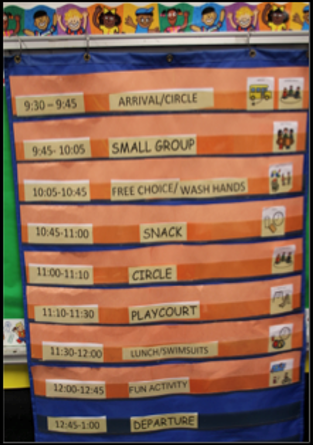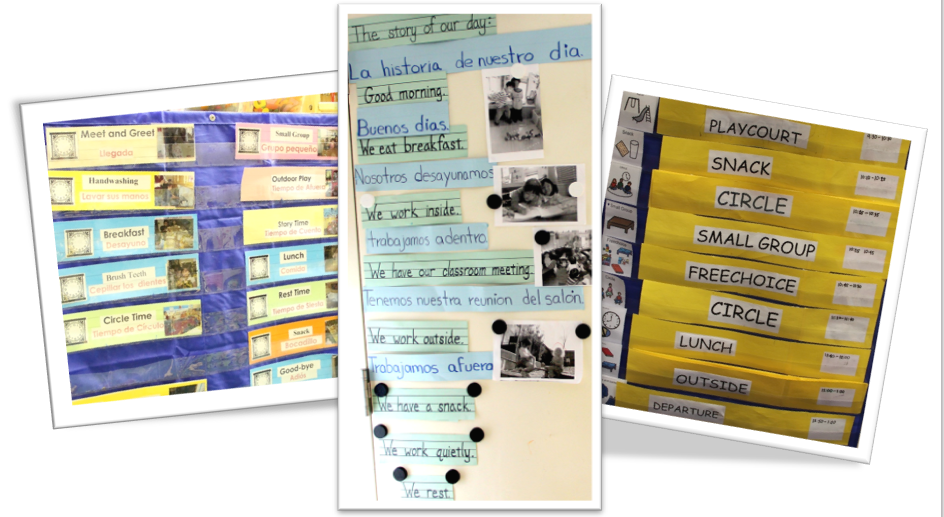7.8: Let’s Take a Closer Look at the Temporal Environment
- Page ID
- 87154
|
|
Quotable The most precious resource we all have is time. How will we use it? - Steve Jobs |
Before your head hit the pillow last night and you fell fast asleep, what did you do? Did you brush your teeth? Did you take a shower? Did you read a book, watch TV or listen to some music? Would you say what you did last night followed the same routine that you do every night or was it unusual? How do you feel when you follow a regular routine? How do you feel when life throws you a curveball and nothing is as it should be? Now, imagine how a child might feel if every day they had to adjust to a new routine; if they never knew what to expect from one day to the next. Imagine how a child might feel if there was a predictable pattern to follow and if they always knew what was coming next.
According to Gordon and Browne (2016), the temporal environment has to do with the scheduling, timing, sequence, and length of routines and activities that take place at home and at school. With predictable schedules, routines, and transitions there is a sense of safety security. With a steady schedule and regular routines, children will be able to adapt to their environment as well as adjust to a new situation that may arise much more quickly. It also frees them up to be able to focus on the task at hand rather than worrying about how much longer they have or what will come next. [104]
The terms routines and schedules are often used interchangeably. Schedules and routines are utilized in preschool classrooms to:
- Help guide the day.
- Communicate to everyone what is happening and when.
- Foster engagement.
- Meet the needs of children to explore, persist, and elaborate.
- Promote a safe and fun place to learn and grow.

Figure \(\PageIndex{1}\): An example schedule [105]
Some considerations about daily routines/schedules include:
- They are a series of behaviors that occur on a regular basis
- Expectations for routines need to be planned and then taught to children.
- Created for developing and learning
- The amount of time for each block will vary and should be flexible.
- Most early childhood program routines include:
- Arrival and Departure
- Group or circle time
- Activities
- Center or free choice time
- Snack time and meals
- Outdoor time
- Transitions between blocks of time
- They are sequenced – to create a flow of the day
- Choice should be incorporated whenever possible.
- They are balanced in terms of:
- Active/quiet
- Individual/small/large group
- Teacher-directed/child-initiated activities
- Noise level, pace, and location
- Teachers should be in tune with children’s needs and engagement and be flexible.
- Shorten or lengthen blocks of time as needed.
- Plan for transitions as carefully as the segments of the routine themselves.
- Posting a routine provides a visual reminder for children.

Figure \(\PageIndex{2}\): More examples of schedules and routines [106]
Incorporating Transitions into your Curriculum
|
|
Quotable “Life is one big transition.” - Willie Stargell |
Transition is another word for change, and change can be challenging. The biggest transition children will experience each day with you is arrival and dismissal, when they move from one of their most important life spaces to another.
All routines include transitioning from one segment to the next. Every transition affords the opportunity to flow smoothly from one experience into the next or to become chaotic and stressful for children and teachers alike. Planning for each transition during the day is as important as planning the experiences themselves. With careful planning and flexibility, we can help children leave their present moment gently and purposefully, moving to the next adventure that awaits them.
|
|
Teacher Tip: Planning for Transitions
|
How does the Temporal Environment Benefit Children?
Each child in your class is unique. When you provide a structured schedule with predictable routines and consistent transitions, you are creating a safe and secure environment where all children can thrive. Be providing clear expectations, you will help children adjust to their surroundings, adapt to the daily schedule and routine, and feel more comfortable knowing what comes next. Once they are comfortable in their setting, children will socialize with their peers, and they will use materials in a more meaningful way. Additionally, when the daily routine is consistent and predictable children are more likely to:
- Feel more confident to explore, create and take risks
- Stay on task and complete activities
- Be more engaged in learning activities and play
- Gain a sense of belonging
- Develop autonomy and independence
- Play more cooperatively and have fewer incidents
Here a few reminders when setting up your temporal environment:
- Post two daily schedules: one for the children down at their eye level, and one for their families on the Family Board
- State clear expectations and provide positive reinforcement
- Review the schedule regularly and adjust as needed based on the needs of the children.
- Keep routines consistent however, be prepared to make changes if necessary.
- Include visuals prompts (photos) on your daily schedule so children can track their day.





